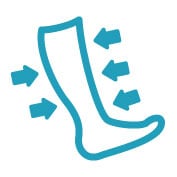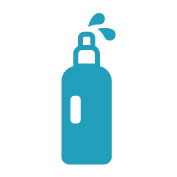
A blood clot in the legs can occur due to accidents or bumping into objects; however, the occurrence ofone out of the blue with no specific reason is a serious issue that needs to be investigated. Deep Vein Thrombosis (DVT) is the term given to an embedded blood clot found in one of the primary deep veins located in the legs or arms.
Deep vein thrombosis happens when a blood clot forms inside a deep vein. Although not immediately hazardous, a deep vein blood clot can develop into a serious condition if it breaks loose. If it’s diagnosed in time, treatment can keep the hazard in check while the blood clot slowly breaks apart. A deep vein blood clot can occur anywhere in the body, but most often forms in the calf or thigh. Treating DVT is important because of the risk of a life-threatening complication known as pulmonary embolism. This occurs when the blood clot breaks off and travels through the blood and blocks an artery in the lung.
Once you receive a diagnosis of DVT, you’ll likely be prescribed medications known as anticoagulants, or blood thinners. These work to keep the clot from growing and to prevent further clots. Research shows that taking these medications at home is just as safe and effective as taking them while in the hospital.
 Top Tips:
Top Tips:
DVT may make it harder for you to get around at first. You should slowly return to your normal activities. If your legs feel swollen or heavy, lie in bed with your heels propped up about 5 to 6 inches. This helps improve circulation and decreases swelling. You can also try these deep vein thrombosis treatments at home:
• Exercise your lower leg muscles if you are sitting still for long periods of time.
• Stand up and walk for a few minutes every hour while awake.
• Don’t wear tight-fitting clothing that could decrease the circulation in your legs.
• Wear compression stockings as recommended by your doctor.
• Avoid activities that may cause a serious injury
• Avoid activities that involve prolonged periods of inactivity
• Elevate your legs regularly to promote blood flow
• Keep a check on your weight and BMI
 Compression Stockings
Compression Stockings
You will likely need to wear graduated compression stockings to get rid of leg swelling. The swelling is often because the valves in the leg veins are damaged, or the vein is blocked by the DVT. Most compression stockings are worn just below the knee. These stockings are tight at the ankle and become looser as they go up the leg. This causes gentle pressure (compression) on your leg.
 Ginger
Ginger
Apart from being an excellent healing spice, ginger plays an important role in treating deep vein thrombosis. It is an effective medicine to break down the fibrins that cause DVT and further helps in smooth movement of blood. Ginger contains a compound called salicylate. A very popular blood thinner called acetylsalicylic acid is derived from this compound. If you drink ginger tea at least two to three times a day, it can help prevent high cholesterol that causes plaque build-up further inhibiting blood circulation.
• Allow the ginger to steep in hot water for 15 minutes.
• Let it cool then drink the tea immediately.
• You can also add honey for flavour and sweetness.
 Keep Hydrated
Keep Hydrated
Dehydration can cause your blood to thicken, increasing your risk of a blood clot. To stay well-hydrated, women should consume an average of 91 ounces (oz) of water from all beverages and food daily, and men an average of 125 oz, according to the National Academy of Sciences, Engineering and Medicine guidelines. One way to check if you’re drinking enough water is to check your urine. If it is a pale-yellow colour or clear, you are drinking enough. If it's amber-coloured or darker, you're not and should increase your daily water intake.
 Garlic
Garlic
Garlic is widely praised to have many health benefits, including possibly breaking up potentially harmful clusters of platelets in the bloodstream. The best way to reap that benefit from garlic is to crush the raw cloves to release their beneficial compounds, then eat them raw, oven-roasted, or boiled for three minutes or less. It’s important to talk to your doctor about how much garlic you should eat if you are taking a blood thinner already, as garlic could interfere with the medication’s effectiveness.
 Diet
Diet
Eat a healthy, low-salt diet. Body weight puts more pressure on the veins in your pelvis and legs. Salt can boost your blood pressure, so keeping your sodium and cholesterol levels low can help you avoid another blood clot. Avoiding animal fats and unhealthy foods is also recommended. Working on losing weight if you're carrying extra pounds as this can also help to improve your condition.
